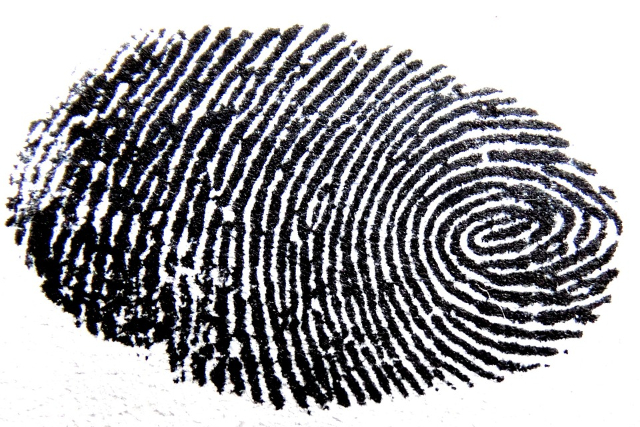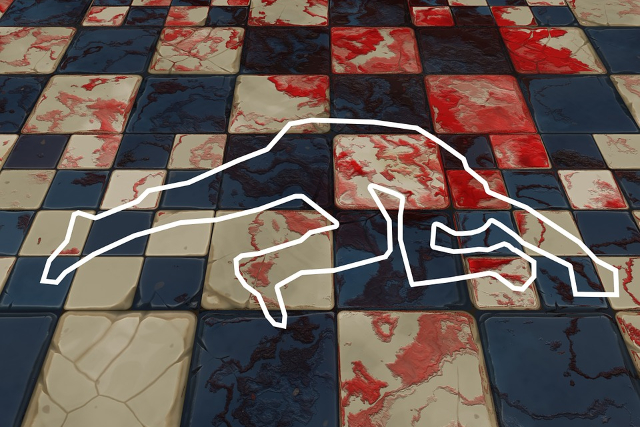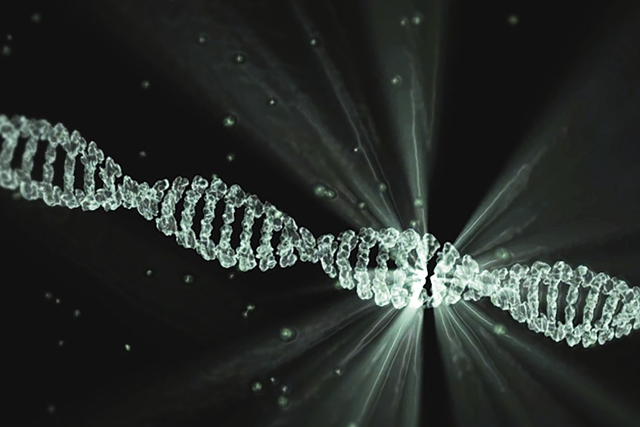Since 2007, the FBI has given out the “Latent Hit of the Year” Award to “an outstanding latent examiner or officer who solved a major violent crime by using the FBI’s IAFIS database.” So what does that mean, exactly? Well, a latent examiner is a forensic specialist who analyzes a crime scene, looking for latent prints, which are accidental impressions of the friction skin on the fingers or palms that have been transferred onto other surfaces.
We all know from movies and TV shows how important fingerprints can be to solving crimes, so the FBI created IAFIS – the Integrated Automated Fingerprint Identification System – a national database used to identify people from their fingerprints. It then created the “Latent Hit of the Year” Award when local and state law enforcement agencies wanted to learn more about how latents could be used to solve major crimes. In 2015, the FBI changed it to the “Biometric Identification Award” in order to include all measurable physical characteristics that can be used to identify people, such as irises and face recognition, not just fingerprints.
Today we will examine some cases whose solutions were good enough to receive this award.
8. Greg Michaud (2007)

We might as well start off with the very first case that was awarded the “Latent Hit of the Year” in 2007, and it was well-deserved as it solved an almost 30-year-old cold case that took place in Big Rapids, Michigan.
On April 23, 1980, 89-year-old Stella Lintemuth had been murdered in her own bedroom, just a few days shy of her 90th birthday. Big Rapids was a small town that did not get a lot of violent crime, so local police were not properly trained to deal with such a case. There was a set of train tracks that ran outside the victim’s home, so they reasoned that the killer was most likely a transient who rode the railway, but that’s about the only lead they had.
Consequently, they received help from a state forensic team, which included latent examiner Jerry Disler. He recovered two prints from the base of an old porcelain lamp, whose cord was used to strangle the victim. That was the only trace that the killer had left inside the house. The police knew that identifying the fingerprints meant identifying the culprit, but they also realized that the chances of this happening were almost zero. This was 1980, after all, and all the police could do was manually compare the prints to the fingerprint cards they had on file. They had no luck, and when Jerry Disler retired 16 years later, the murder of Stella Lintemuth was still an open case.
That is why decades later it got passed on to Greg Michaud, another forensic scientist who first heard of the case during his training program. In 2006, he realized that probably nobody had ever run the prints through IAFIS, since the database did not exist at the time of the original investigation. He tried it and got a hit – Scott Elwood Graham, at the time already confined to a mental institution. Graham was found guilty in 2009 following a short six-day trial.
7. Hoi Lui (2008)

The second case to be awarded a “Latent Hit of the Year” Award was even older than the first. On April 30, 1977, rookie forensic examiner Chuck Gaylor had been called in to a crime scene in Escondido, California. The bloody and beaten body of 24-year-old migrant worker Liborio Lindin had been found in the garage of a home under construction. A violent fight had clearly taken place inside the garage which was covered in blood. Among the evidence discovered at the scene was a partial bloody fingerprint, but nothing to ID the killer. The case went unsolved, becoming the oldest cold case in the history of Escondido.
Fast-forward to 2007. Chuck Gaylor had retired by that point, but he took a new job with Escondido PD as a reserve officer heading a cold case team. The Lindin murder from his rookie year came across his desk and he decided it was time to put it to bed. However, right off the bat, there was another huge setback. In the decades that had passed, the property room of the Escondido Police Department suffered a major rat infestation and the rodents destroyed a lot of evidence. All that remained intact from this case were the crime scene photos and one image of the bloody partial fingerprint.
The task of working on the print fell to latent examiner Hoi Lui, who modified it in various ways until she got a usable print. Lui ran it through IAFIS and got 20 possible matches. After about 100 interviews across the country, the team had their man – Michael Moon, a carpenter who had already been imprisoned and paroled for another murder and an attempted murder, on separate occasions. Despite his priors, Moon was sentenced to only eight years for Lindin’s death, and was paroled again after serving four.
6. James Ramsey & Jill Kinkade (2011)

Some cold cases that were awarded the “Latent Hit of the Year” can go back even further, such as the 2011 case dated to 1969. On December 14 of that year, 25-year-old phone operator Diane Maxwell was attacked on her way to her job at Southwestern Bell in Houston, Texas. She was raped, murdered and dumped in an abandoned shack before her killer drove off in her ‘68 Mustang.
In the decades that followed, Diane’s brother David Maxwell became a Texas Ranger, hoping to one day close the file on his sister’s murder. In 1986, he got the case reopened, but still had no luck in finding the killer. In 2003, he did it again, this time turning to Houston PD homicide investigator Jim Ramsey, who became lead on the case. In turn, he asked latent print technician Jill Kinkade for help with the forensics.
Like with the previous entry, the investigators were dismayed to discover that the evidence in the case had been tainted over the course of decades, but this was a little worse than just some rats. For whatever reason, a lot of the evidence had simply been thrown out, while the crime scene photos had been removed from the property room and sold to a detective magazine.
Hoping that some of the evidence had only been misplaced, investigators began scouring cold case files and, after a month of searching, they struck gold. They found the cards with the fingerprints that had been lifted from inside the Mustang, accidentally placed in a file from 1986. It was the only evidence left in the case, but it was the only one they needed. Kinkade ran the prints through IAFIS and got the results in just a few hours. Their number one candidate was a man named James Ray Davis, who had been in and out of prison since the early 60s. He confessed his crime during an interview and was sentenced to life in prison.
5. Doug Herout & Laura Casey (2012)

This case from 2012 had the kind of drama and flair that you would expect from a murder in a book or a movie. Back on October 17, 1978, Carroll Bonnet of Omaha, Nebraska, was found dead in his apartment after failing to show up for work. He had been stabbed and stripped naked, while his apartment showed clear signs of a violent struggle. Next to the body, the killer left a taunting note for the police which said “I am leaving this crime with only one clue. Find it yourself Pig!!! Die Pig. – Helter”.
So what was it? The forensic team found plenty of signs of the killer’s presence – there were two prints in the bathroom, cigarette butts in the trash can, bloody towels on the floor, an open beer can in the kitchen. However, none of these looked like an intentional clue left behind to provoke the police. The killer left in the victim’s car, a 1964 Buick. It was later recovered and more prints were found inside the vehicle, but still nothing that led to the criminal’s identity.
Fast forward to 2008 and Omaha PD opened a cold case unit led by Detective Doug Herout. Forensic technician Laura Casey ran the prints through IAFIS and got a hit – Jerry Watson. However, just the prints weren’t enough. He could have had a good reason for visiting Bonnet’s apartment. Instead, they served as the starting point for the team’s investigation into Watson. Following an interview, they got a DNA swab and that was when all the other evidence started to line up. The cigarette butts – matched to Jerry Watson. The beer can – matched to Jerry Watson. A hair found at the scene – matched to Jerry Watson. Pretty much everything pointed at him so Watson was charged and convicted with the murder.
But what was the clue the killer left behind? This was 1978, after all, and Watson couldn’t have predicted the role DNA would play in his arrest decades down the line. Instead, he left a newspaper next to the body, with the signature “Jerry W.” written in cursive and then scribbled out, so he had literally signed his handiwork.
4. Melvin Grover (2015)

2015 was the first year when the FBI gave out the Biometric Identification Award, modified to include all biometrics and not just fingerprints. At the same time, IAFIS had been replaced by the more advanced Next Generation Identification, or NGI System, which included a host of services meant to support law enforcement agencies.
That year’s award went to Detective Melvin Grover with the Norfolk Police Department in Virginia. As a reminder, the award is for solving all kinds of major violent crimes, not just murder. In Grover’s case, the new NGI System helped him solve a brutal double rape, committed on the same victim, four weeks apart.
After the first attack in August, 2008, police recovered DNA and fingerprints at the scene, but couldn’t match it to anything in their system. The second attack, four weeks later, was far more heinous, as this time the criminal assaulted not only the same woman, but also her daughter. Again, investigators found more prints at the scene which confirmed that both crimes had been committed by the same person, but they did not match to anything in their databases.
The trail went cold until 2010 when an unexpected lead came from Kuwait. Military investigators were looking into the attempted rape of a female officer and DNA at the scene connected it to the attacks in Norfolk. It looked like the same man was responsible, but still no suspects.
The breakthrough finally came in 2013 when the FBI implemented the new NGI System, which allowed civil records to also be included in latent searches. The police got a match to a man named Amin Garcia who had served as a reservist and was in Norfolk and Kuwait at the time of the attacks. He was subsequently found guilty in both cases.
3. San Bernardino County Sheriff’s Department (2016)

In 2016, the award was presented to the entire San Bernardino County Sheriff’s Department in California for solving a cold case murder from 25 years earlier.
Back in 1991, the sheriff’s department responded to a dead body found in a motel room in the city of Victorville. The victim, later identified as John Miller, had been strangled with a towel and left under the mattress. His killer then stole his Chevy pickup, which was recovered a few days later. Despite the violent nature of the crime, investigators were having difficulty finding any useful clues left behind by the killer. Ultimately, they only recovered a single latent print from the car’s driver-side mirror, which the culprit probably adjusted out of habit and forgot to clean it. Even so, that one print was not enough to provide the police with an ID and the trail went cold.
Decades later, in 2008, the sheriff’s department created a cold case unit consisting of two homicide detectives and a deputy district attorney. In 2010, John Miller’s unsolved murder came across their desks, so they ran the print again. No luck in state databases, but the FBI’s IAFIS had a match to a Michael Arrowood, who was living in Tennessee at the time.
Police had an interview with Arrowood, and he eventually confessed to the crime, but specified that it was his brother, Chris, who actually killed Miller. According to him, the three of them went back to Miller’s motel room for beer and pizza, but the brothers decided to rob and kill him when they discovered that he had $1000 in cash on him. Trace DNA evidence on the towel confirmed that Chris Arrowood strangled John Miller and both brothers were arrested, charged and convicted.
2. Jenny Hall & Meghan Blackburn (2017)

The 2017 award, which went to investigators Jenny Hall and Meghan Blackburn with the Austin Crime Lab in Texas, recognized a clever solution that one might expect to see in an episode of CSI rather than real life.
Again, we are not dealing with a murderer here, but rather a vile child predator who had shared images of a nine-year-old girl inside a Dropbox account back in 2015. The Texas Department of Public Safety, or DPS, received a tip about his online activity, but were struggling to find out who he was. There were no obvious identifiers in the pictures, but the aforementioned investigators noticed that the criminal’s hands were clearly visible in many shots. In fact, the high quality of the images allowed them to see the ridges of his fingerprints so they thought that maybe they could reconstruct his fingerprints just from the pictures.
What followed was a bunch of careful calculations, measurements, and a bit of “filling in the blanks” in order to get the right scale and dimensions of the hands. The end result were composites for the fingerprints visible in the pictures, but they were good enough that they soon got a hit in the FBI’s NGI System. The suspect was identified as Robert Bossick Jr., who later confessed his crime and had hundreds more of the same kind of videos and pictures. He was sentenced to 50 years in prison.
1. Las Vegas Metropolitan Police Department (2018)

The 2018 Biometric Identification Award went to the Las Vegas Metro PD. Once again, it wasn’t murder, but rather a burglary and attempted sexual assault. However, Las Vegas police were fearful that, unless apprehended, their criminal would strike again soon.
The case began one night when the female victim woke up with a stranger in her bedroom. He pounced on her and, following a struggle, demanded to know where she kept the money. After she pointed at a jar near her bed, the burglar left with the gigantic sum of $26.
Despite his haphazard attack, the suspect proved to be surprisingly adept when it came to leaving no traces behind. There was almost no sign that he had been inside that house. He was good, but the forensic team proved to be better, and they recovered two latent palm prints.
It’s quite rare that a case yields only usable palm prints without any fingerprints, but that was what happened here. Unsurprisingly, the local database showed no matches, but fortunately for the Las Vegas PD, the FBI’s NGI System also included a palm print database, which had around 15 million entries at the time. It was double fortunate that their suspect was among them, and he was identified as Phillip White, who was later convicted of attempted sexual assault.
This was a pretty straightforward case, albeit one with an unusual forensic clue, and, for now, it remains the last case to have been presented with the Biometric Identification Award.